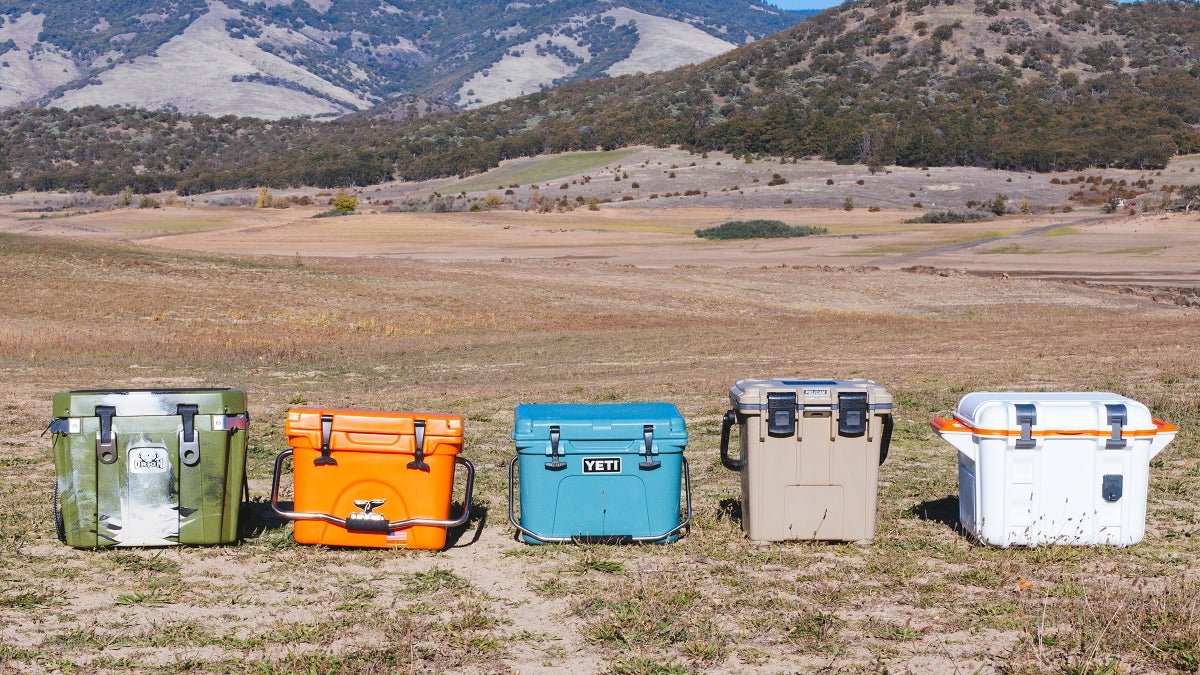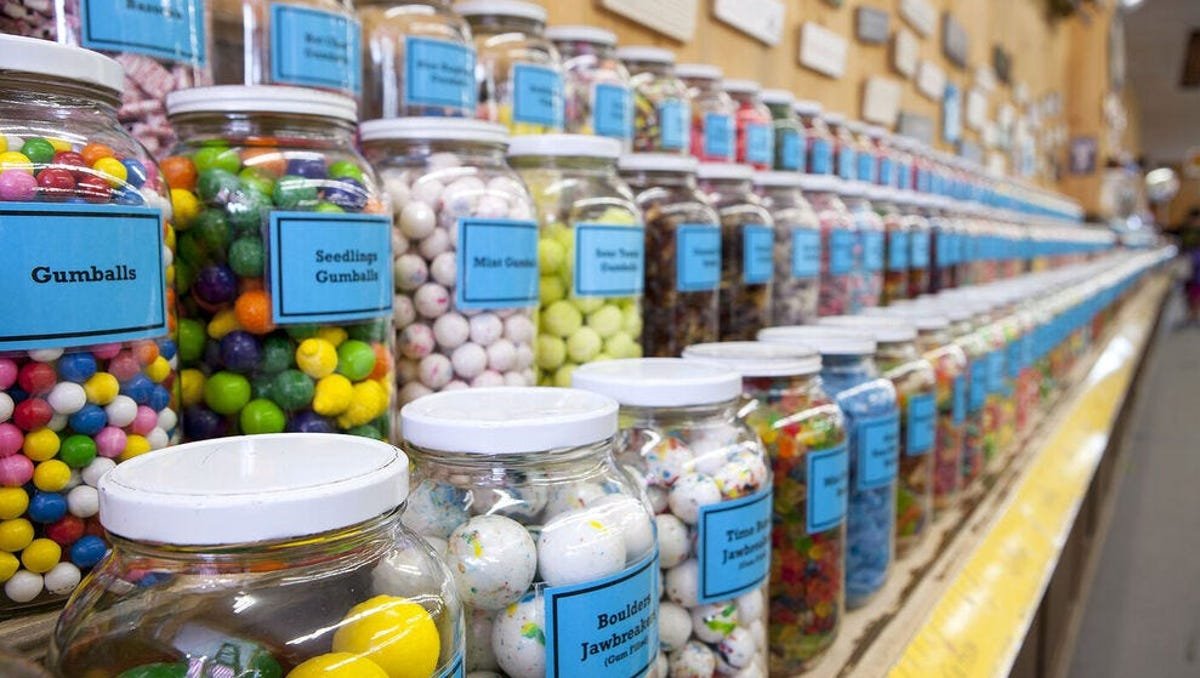Published August 9, 2025 03:08AM
Destinations & Things To Do
The 6 Best Hard Coolers for Camping, Boating, and Fishing (2025)

Coolers are the gastroenterological core of every camping trip. If your cooler fails, your drinks are only lukewarm and your perishables go bad. While ice retention, exterior durability, and interior capacity are all important features to consider, we also think the devil is in the details when it comes to buying the right cooler. A massive amount of insulation won’t do you any good if the clasps don’t seal it closed, and spaciousness doesn’t matter if you can’t find things or carry it. After months of testing, here are the six best coolers for car campers, vanlifers, and beach bums.
Watch: How to Choose a Cooler
Best Coolers: At a Glance
Best Overall
Yeti Roadie 32 Wheeled Cooler
External Dimensions: 16” x 18” x 21”
Capacity: 32 L
Weight: 24.5 lbs
Score: 9.5/10
Pros and Cons
⊕ The most portable cooler of our test
⊕ Retained coolness beyond testers’ expectations
⊕ Took months of beating with aplomb
⊗ Tall height means it has to be packed thoughtfully
For as much as we didn’t want to deliver yet another win to Yeti, it felt like betting with the house. We could not ignore how well the Roadie 32 Wheeled Cooler performed in every aspect of our test, and it became my family’s favorite cooler for five months of adventures. This model is a smaller, upgraded version of the Roadie 48 Wheeled Cooler, which we also tested and loved. While testers initially questioned why a 32-liter cooler needs wheels, they quickly realized the benefits. Five-inch-diameter, off-road-capable wheels made navigating rough terrain manageable. We also appreciated the 26.5-inch-long telescoping handle—five inches above the height of the cooler—which made it easy to maneuver even when the cooler was fully loaded.
As for the cooler body, it’s made out of Yeti’s famous rotomolded polyethylene that came away without damage after months of consistent hard use transporting perishables around campsites and being errantly left outside for months. The footprint of the base is slightly smaller than the lid, which, coupled with the taller height (to accommodate wine bottles), packed neatly into a variety of vehicles. On the thermoregulating front, the pressure-injected polyurethane insulation kept an entire cooler’s worth of food satisfactorily cold with only a Yeti Blue Ice pack tucked inside for two full days with highs over 102 degrees—far outperforming our expectations of a cooler only chilled with an ice pack. Plus, the single drain plug never leaked.
Best for True Connoisseur
Snow Peak Hard Rock 40-Qt Cooler
$454 at Backcountry $648 at Snowpeak
External Dimensions: 25″ x 16″ x 15″
Capacity: 38 L
Weight: 25 lbs
Score: 9/10
Pros and Cons
⊕ Beautiful design
⊕ Thoughtfully built to last forever
⊗ Expensive
The Hard Rock 40 is a collaboration between two brands with sterling reputations: Grizzly Coolers’ products are bomb proof, and Snow Peak’s Japanese aesthetic is sleek. The result is a cooler so sexy that four testers did not even bat an eye at the eye-watering price. The bear-proof rotomolded cooler easily kept our perishables cold on a four-day camping trip in California’s North Coast, retaining about 80 percent of the ice block in temps with highs in the 70s.
Testers noted that the Bear Claw Latch System rubberized closures, which wrap over and around rectangular knobs to lock down the cooler, made the cooler impossible to unintentionally crack open and let air out when closed down. Those closures also look cool as hell with contoured edges and a low-profile design that integrates seamlessly with the cooler body. Its matte finish and subtle, claw-like silhouette give it a tactical-meets-minimalist look that’s both tough and sleek. Not only does this closure design make the cooler virtually impervious to animals without prehensile fingers, it makes it easy to latch and unlatch with one hand. The drain plug is just as easy to crank open and closed. Like the other premium coolers in this category, it is rotomolded with a hefty serving of polyethylene, which makes it impervious to the beating we delivered during months of car camping and gives it lifelong durability.
Best Value
Igloo ECOCOOL Latitude 52-Qt Cooler
External Dimensions: 25″ x 15″ x 15″
Capacity: 49 L
Weight: 9.8 lbs
Score: 7/10
Pros and Cons
⊕ Good bang for your buck
⊕ Sustainable materials
⊗ Not as insulating as the other coolers on this list
⊗ No drain plug
The ECOCOOL Latitude 52-Qt cooler proves that there is still space for a low-tech cooler in a market dominated by $400 beasts that hold onto ice for weeks. For $60, the ECOCOOL did a respectable job of keeping snacks and drinks cold during a 60-degree weekend of camping in Oregon’s Siskiyou Mountains. Would we want to depend on it for a multi-day river trip? No. But that isn’t what this cooler is designed for. Rather, this cooler is made for more casual car camping. Testers reported that the handles didn’t bend under a 50-pound load, and the lid’s solid hinge and sturdy clasps added to its potential longevity. As a bonus, the ECOCOOL is made from post-consumer recycled resin. One feature we would’ve liked to see: A drain plug.
Best for Boaters
Bote Kula 10
External Dimensions: 24” × 15″ × 19″
Capacity: 38 L
Weight: 24 lbs
Score: 7.5/10
Pros and Cons
⊕ Rounded sides packed well into crowded boats
⊕ Top holds two cans steady on rocking boats
⊗ Does not play well with ice blocks
⊗ Handle is too big for packing tightly
Boaters notoriously pack a lot of drinks (usually beer), and the Bote Kula 10 has the capacity for quenching their thirst. “This cooler was built to party,” reported one tester, who found the included bottle opener easy to use and appreciated the magnetic aluminum can holders while rowing down a Class II stretch of river. Teetotalers, on the other hand, found the bottle opener to be a little much. Cylindrical beverages, such as cans of beer or bubbly water, packed efficiently against the interior’s rounded corners. Those same rounded corners on the exterior helped it squeeze into the rarely square, open spaces of the 13.5-foot Sotar Raft we tested it in. The only downside of the rounded body was it did not play well with blocks of ice that typically tuck beautifully into the corners of classic square coolers. This posed a problem on our hottest camping trip on the Klamath River, in which bags of crushed ice didn’t stand a chance against triple digit temps.
Best Braun for the Buck
RTIC 65 QT Ultra-Tough Cooler
External Dimensions: 31.62” × 17.5” × 17”
Can Capacity: 84 Cans (No Ice)
Weight: 38 lbs
Score: 8.5/10
Pros and Cons
⊕ Incredible durability throughout
⊕ Smart accessories
⊗ So heavy
With an admirable 3 inches of foam built into the body, the Ultra Tough held its own in terms of ice retention against similarly-sized and rotomolded Yeti coolers but at a more affordable price point. We were also impressed with this cooler’s padded rope handles, which allowed for comfortable carry even when filled with a family of three’s food and drinks for a weekend camping trip. Every tester agreed that having two drain plugs was a significant bonus for both removing excess water and cleaning. It drained two blocks’ worth of melted ice in under five minutes and removed enough of the water that we only had to wipe it with a washrag upon our return. Non-skid feet added a little extra traction when loaded into the back of a truck.
At more than $200, this RTIC cooler is still not cheap, but it’s $150 less than its Yeti counterparts and has a solid chance of lasting just as long thanks to durable design details, from the hardy clasps to the thick rope handles. One downside of all of that burl? At nearly 38 pounds empty, it was the heaviest cooler we tested—even heavier than one with a built-in refrigeration system.
Paid Advertisement by Backcountry.com
Canyon Coolers Pro 65qt Cooler
Looking for a cooler built to withstand a long and happy life filled with campsites, beaches, and backyard BBQs? Meet the Pro 65 from Canyon Coolers, a 66-quart ice chest featuring pressure-injected foam insulation with a durable rotomolded construction. This hard-sided cooler also features a divider that can be used as a convenient side table, oversized latches for secure closure, and oversized drain plugs for easy cleaning.
Best For Vanlifers
Dometic CFX-2 45
$880 at Backcountry $880 at Dometic
External Dimensions: 16” x 19” x 27”
Capacity: 45 L
Weight: 40 lbs
Score: 8/10
Pros and Cons
⊕ Really efficient
⊕ Can keep ice indefinitely with power source
⊗ Need access to power
⊗ Lid can make accessing food at bottom difficult
Built with integrated cooling systems, Dometic coolers are marvels of modern cooler science. Dometic’s game-changing, hyper-efficient electric coolers essentially invited mini-fridges into our vans, truck conversions, and even campsites—as long as you have a converter or generator to plug them in to. But what we love about the CFX-2 45 doesn’t have to do with electronics; it’s that it’s tough as hell. Our test model spent a vast majority of its time in the back of a 2020 Ford Transit, pulling double duty as a cooler and a step-stool for kids ranging from 35 to 65 pounds. We never had to worry about denting or cracking it. Credit goes to the reinforced corners, stainless steel hinges, heavily fortified plastic folding handles, and thick lid.
With the ability to connect to 12/24 volt car DC as well as 100-240 volt home AC, testers plugged it in at home before packing up the night before to maximize charge and coolness. Once on the road, it stayed plugged in at all times to retain cold air. Since the lid swings up from the top, rather than off the side, testers noted that food at the bottom can be tricky to reach. But that slight annoyance didn’t bother us too much during a two-week cross country trip. Our only real complaint is the $800 price tag, but it’s hard to even fault Dometic for that since the CFX-2 45 is essentially a portable mini fridge.
Cooler Comparison
| Cooler | Price | Score | Pros | Cons |
| Yeti Roadie 32 Wheeled | $375 | 9.5/10 | Most portable; retained coolness beyond expectations | Tall height requires thoughtful packing |
| Snow Peak Hard Rock 40-Qt | $648 | 9/10 | Beautiful design; built to last | Expensive |
| Igloo ECOCOOL Lattitude 52-Qt | $60 | 7/10 | Good bang for your buck; sustainable materials | Not as insulating; no drain plug |
| Bote Kula 10 | $331 | 7.5/10 | Packs well into crowded boats; top holds 2 cans steady | Does not play well with ice blocks |
| RTIC 65-Qt Ultra Tough | $242 | 8.5/10 | Durable; smart accessories | So heavy |
| Dometic CFX-2 45 | $880 | 8/10 | Really efficient; can keep ice indefinitely with power | Needs access to power |
Other Products We Tested
- Oyster Tempo Cooler ($445): This iceless cooler blew testers’ minds with how quickly it dropped in temps when we threw cold packs in it. But the stainless steel exterior proved susceptible to scratches and dings.
- Igloo IMX 70 Qt Cooler ($250): We loved this cooler’s hardy design details, like the metal rope handles; but in the end we decided the RTIC 65 was a better overall choice in this size and price class.
- RTIC 32 qt Ultra Light Cooler ($144): RTIC did a great job of lightening up this cooler while maintaining fantastic thermoregulation with its super deep, heavily insulated lid, but it did not perform as well in either ice retention or durability as its heavy duty RTIC counterpart that made this list.
Products to Avoid
Single Use Coolers: To be honest, coolers have traditionally been a pretty non-eco friendly outdoor gear category. Their plastic exterior and foamy plastic insulation does not have the best track record for the earth or the health of those who manufacture it. A case can be made that most coolers have some environmental blood on their latches. With that said, nothing is more wasteful than a single-use cooler. On top of going immediately into a landfill, they don’t really do anything in terms of insulating their contents either. They are both wasteful and pointless.
How to Choose a Cooler
What Size Cooler Is Best?
Pick a cooler that’s big enough for your average trip length. If you get a cooler that is too small, you will go hungry, but a cooler that is too big will create coolness-wasting dead space. Each trip is different and group size can change things, but as a very general rule of thumb, I like to bring a 20- to 45-liter cooler on day- to weekend trips for my family of three, and a 55- to 70-liter cooler on trips lasting three days to a week.
Do You Really Need an Expensive Cooler?
This is a really tough question to answer as an individual who is obsessed with fancy coolers but spent most of his life using the cheapest coolers available. The short answer? If you are a reasonable drive from a place with ice and are camping for a weekend, you don’t need a cooler that can hold a single block of ice for a fortnight. Is it a good investment to buy a durable cooler (usually an accompanying factor in a pricey cooler) even if you don’t need it to retain ice forever? Yes, I think spending some extra dough is worth it.
What’s the Best Way to Pack a Cooler?
A cooler is only as good at retaining ice as the person using it. If you have a $400 cooler built to keep ice solid through the entirety of a Grand Canyon trip, but you leave it wide open in the sun for an hour on a super hot day, you just robbed that cooler of its ability to keep its contents cold.
I could write another 2,000 words on cooler maintenance, but there are three main rules you should follow: One: Try to reduce the cooler’s temperature before your trip, and keep it in the shade. The heat of the cooler itself drastically changes performance. Two: Keep the lid shut as much as possible. That means grabbing food with purpose rather than rummaging around. It also means grabbing multiple things at a time, such as all your sandwich fixings, and then immediately closing the lid rather than opening it once for ham, once for mayo, and once for cheese. Three: If your cooler has latches, keep them tight after every opening.
How We Test
- Number of coolers tested: 12
- Number of testers: 12
- Days camped: 30+
- Meals eaten: 80+
- Days rafted: 6
- Trips to the beach: 10
- Number of coolers accidentally left in a side yard for 5 months: 1
We had an absolutely epic end of summer, fall, and early winter adventuring with these coolers, aiming to give them the most real world scenarios to see how they held up in the mountains, on beaches, and on rivers. Our group of 12 testers used them on five main testing trips in three states ranging in weather from blazing hot to frigid rain. While general durability, capacity, and ice retention are all extremely important factors, we also spent hours poring over the finer details like the handles, closures, and drain plugs to tease out the nuance of what made them worthy of this guide.
Meet Our Testers
Joe Jackson made a name for himself testing coolers during his first year working at Outside over a decade ago. Ever since he has been obsessed with the intricacies of closed cell foam, durable rotomolding, and keeping every goddamn lid closed to not let out all of the insulated air. His love of cooler testing and maintenance started during the ten years he worked as a raft guide and was solidified the year he managed a rafting company that cooked all of its meals out of food stored in coolers.
Sarah Jackson absolutely and utterly doesn’t fuck around when it comes to cooler packing and maintenance. She is the person everyone asks where the cheese is packed (even if it isn’t in her cooler) and has been known to move a cooler half a dozen times to keep it in the deepest shade on a hot campsite. She has tested, loved, and even destroyed coolers with her husband, Joe, for over a decade.
Zach “Red” Williams uses his 2020 Ford Transit and teacher’s schedule to maximize adventure for his family of four. He tested coolers for us on multi-week road trips, weekend camping trips, tailgating in ski resort parking lots, and rafting trips.
More Gear Reviews
The 8 Best Instant Coffees for Backcountry Adventurers
Yeti’s New Hondo Beach Chair, Tested and Reviewed
The Best Portable Camping Chairs for Fireside Lounging
Destinations & Things To Do
How Canicross Saved My Relationship with My Unruly Rescue Dog

I couldn’t fix my dog’s behavior until we started running toward a shared goal—literally
(Photo: Vect0r0vich/Getty, Abigail Wise)
During the first year of living with Halle—a German shepherd-bordie collie mix adopted at ten months old—I felt like a prisoner to my pet.
When guests came over, she believed it was her duty to drive out the invaders from our house, barking nonstop until they walked out the door. If we left her alone at home, she would panic, pace, and become destructive—I once swiftly returned after seeing her attempting to chew through her wire crate in the doggy viewing camera I’d installed. Outside, Halle screamed and threw her body against the leash when she saw another dog, overcome with strong emotions. She obsessed over rabbits and squirrels, blowing me off to pursue them; she once killed a baby bunny while leashed, snapping it up and shaking it to death before I could say “leave it.”
On the advice of trainers, I shrank our lives. I walked her early in the morning on steep, loose trails that no one else wanted to hike. Friends no longer came over to the house. If we saw a dog while we were out, I would sometimes hide with Halle behind a bush or car. In my quest to calm her down, most of my non-essential income went to trainers. One, after ten lessons with no result, suggested that perhaps some day Halle might simply “grow out of it.”
Today, more than two years after adopting Halle, we are in a better groove. Our communication is clearer, and many of her worst impulses have been tamed. I credit our success to better training advice and discovering canicross.
For those unfamiliar, canicross is the sport of trail running with your dog attached to you—and, ideally, pulling ahead. The dog wears a special harness that allows unfettered movement, which is clipped to a bungee line attached to the human’s running waist belt. Originally an off-season activity for sled dogs, handlers use similar commands to mushers, instructing their dogs to “hike” and “gee” and “haw”—AKA hurry up, go right, and go left. In recent years, the sport has taken on a life of its own, with national organizations, local groups, and races.
For Halle and me, it started as a bit of an accident. Tired of being dragged by her on our pre-dawn hikes, I made a knot in her 15-foot leash, clipped it around my waist, and ran a three-mile loop on the trails (note that I do not recommend this sketchy setup). For once, her frantic behavior was not a problem—instead, her pulling made my uphills a little easier.
Later that day, I took her on a walk through a busy park on the same long leash. She didn’t bark or lunge at the dogs; she seemed more interested in exploring and sniffing. Maybe the run removed some of her pent-up frustration.
So much of what we ask of pet dogs is in conflict with their instincts and desires. For instance: walking by our sides. Many dogs naturally walk faster than us—meeting our pace probably feels like getting stuck behind a slow driver in the left lane. Dogs want to explore, sniff, and run in their limited time outside, and walks on a short leash can’t satisfy those needs.
Of course, dogs still have to fit into our world—learning to walk nicely on a leash, come when called, potty outside, and otherwise behave are essential to living harmoniously with humans. But when dogs don’t have outlets for their natural behaviors, owners sometimes find themselves playing dog training whack-a-mole, engaged in a never-ending battle to stop problematic barking, pulling, jumping, and digging.
That’s why having a mutually enjoyable activity is so important. A shared sport bolsters the canine-human relationship, which in turn makes it easier to do necessary-but-less-fun training.
By allowing Halle to run full-steam ahead, we finally had a shared purpose: shredding the trails. I found an online class on pulling sports and ordered proper equipment. Halle learned commands for walking to the end of the leash, speeding up, slowing down, left turns, and right turns.
I taught her that sudden sniff stops were a no-no, as was dragging me down loose slopes, but those rules came relatively easily just like how we humans accept rules in sports and board games.
Outside of canicross, we also focused on life skills, teaching a reliable “come” and “heel,” and practicing around dogs, squirrels, and other distractions. We used play to build impulse control, too, progressively strengthening her “drop it,” “wait,” and other commands around toys she was eager to chase.
Last fall, I met with another Reno canicross runner and her dog, and saw how all the running and training had paid off. I was nervous ahead of the run with Halle’s history of unruly and explosive behavior around dogs.
We started the run behind the other team. Halle was amped to see another dog, but she channelled her energy into pulling me up a switchback. Within 20 minutes, we were jogging and hiking close enough to have a conversation. Halle looked unsure around the new dog, but also glanced backward with worry when we lost sight of them after turning a corner—she seemed to realize we were a group and wanted to stick together. She made more progress over a one-hour run than she had over multiple training sessions with a trainer’s dog. She and Chase, the husky-pitbull mix, are now good friends.
In April, we entered our first race together in Susanville, California. Halle hunched nervously between the runners as we were crammed together at the start line. But once we started running, she was on fire. I flew the first two miles as she threw her weight into the harness—race volunteers joked that I was cheating (it was a dog-friendly race, but not explicitly canicross). She galloped past distractions she’d never encountered before, including photographers and volunteers ringing bells. After missing an unlabelled turn, we ended up running an extra mile and a half, but she was a better sport about it than me. She got her second wind after seeing a squirrel at mile five, giving me a much-needed boost.
After the race, we basked in our accomplishment. We might have botched the actual course, but we had cleared a hurdle in a larger race. In a new place amid crowds, our teamwork had shone through, and we ran together without a hitch.
Now, I’m organizing group runs in my area to build more interest in the sport. Maybe other people struggling with their pups can realize the potential and teamwork that canicross brings about.
Destinations & Things To Do
HGTV said you must visit Chutters candy counter, Wild Blueberry Land

Deer crashes into popular brunch spot
The Friendly Toast, a popular brunch spot in New Hampshire, delayed opening after a deer crashed through their window.
Summer’s almost over, why not end it with a classic family road trip?
And these two stops might be the road trip destinations you’re looking for.
HGTV ranked the top 50 must-see roadside attractions in the United States, with one for each state, and the Home and Garden Network named two locations as New Hampshire’s and Maine’s best roadside attractions.
“Most of these stops are located right off major highways for easy hop-out and hop-back in photos,” HGTV said. “But there are a couple of gems worth the county road detour that we couldn’t resist including.”
Here’s what HGTV picked as the best and most eye-catching roadside attractions in New Hampshire and Maine.
Chutters, Littleton
HGTV chose Chutters as New Hampshire’s most stunning roadside attraction because of its record-breaking confectionary feat as well as its historic longevity.
What HGTV said about it: “No road trip would be complete without snacks, and if you’re driving through New Hampshire, you have to stop at Chutters—especially if you have a sweet tooth. Home of the world’s longest candy counter, this sugary shop in Littleton, New Hampshire, has been on Main Street for more than 100 years, and it features 112 feet of glass containers with all kinds of rare, nostalgic confections. And while the candy is most famous, don’t miss Chutters’ homemade fudge and chocolate, too.”
You can find Chutters at 43 Main St. in Littleton, New Hampshire. It operates from 10 a.m. to 5 p.m.
“Grab a bag and choose from the vast array of sours and gummies, gourmet and traditional jellybeans, chocolates, licorice, caramels, and nostalgic pieces,” the Chutters website said. “Chutters is a treasure trove of tasty treats!”
Wild Blueberry Heritage Center, Columbia Falls
HGTV chose the Wild Blueberry Heritage Center because of how it highlights one of Maine’s most prized culinary achievements: cultivating the wild blueberry.
What HGTV said about it: “If you didn’t make a pitstop for a lobster roll, you didn’t road trip through Maine. However, The Pine Tree State also boasts another hallmark eat: wild blueberries. And the Wild Blueberry Heritage Center (formerly Wild Blueberry Land) on Route 1 in Columbia Falls is the place to get your fix. Handbuilt by wild blueberry farmers Marie and Dell Emerson in 2001, the bakery-meets-museum is literally shaped like a blueberry, with additional quirky structures to pose with. There’s a blueberry pie canopy, a blueberry throne, and inside you’ll find tasty treats, from fresh-baked pies to wild blueberry coffee.”
You can find the Wild Blueberry Heritage Center at 1067 U.S. Route 1 in Columbia Falls, Maine.
The heritage center operates from 10 a.m. to 5 p.m., opens its doors starting June 27, and closes its doors on Oct 13, the Wild Blueberry Heritage Center website said.
Rin Velasco is a trending reporter. She can be reached at rvelasco@gannett.com.
Destinations & Things To Do
Bangkok continues to strengthen its reputation as a top tourist destination

The campaign targets key markets including India, China, Malaysia, Laos, and Vietnam, offering special deals on accommodation, travel packages, and shopping, alongside promoting emerging tourism trends such as wellness travel, music festivals, sports, and international events.
“The government reaffirms Thailand’s readiness as a world-class destination, offering safety, service excellence, and unique charm, while continuing to strengthen the tourism sector for sustainable growth,” Sasikarn said.
-

 Brand Stories3 weeks ago
Brand Stories3 weeks agoBloom Hotels: A Modern Vision of Hospitality Redefining Travel
-

 Brand Stories2 weeks ago
Brand Stories2 weeks agoCheQin.ai sets a new standard for hotel booking with its AI capabilities: empowering travellers to bargain, choose the best, and book with clarity.
-

 Destinations & Things To Do3 weeks ago
Destinations & Things To Do3 weeks agoUntouched Destinations: Stunning Hidden Gems You Must Visit
-

 Destinations & Things To Do2 weeks ago
Destinations & Things To Do2 weeks agoThis Hidden Beach in India Glows at Night-But Only in One Secret Season
-

 AI in Travel3 weeks ago
AI in Travel3 weeks agoAI Travel Revolution: Must-Have Guide to the Best Experience
-

 Brand Stories1 month ago
Brand Stories1 month agoVoice AI Startup ElevenLabs Plans to Add Hubs Around the World
-

 Brand Stories4 weeks ago
Brand Stories4 weeks agoHow Elon Musk’s rogue Grok chatbot became a cautionary AI tale
-

 Brand Stories2 weeks ago
Brand Stories2 weeks agoContactless Hospitality: Why Remote Management Technology Is Key to Seamless Guest Experiences
-

 Asia Travel Pulse1 month ago
Asia Travel Pulse1 month agoLooking For Adventure In Asia? Here Are 7 Epic Destinations You Need To Experience At Least Once – Zee News
-

 AI in Travel1 month ago
AI in Travel1 month ago‘Will AI take my job?’ A trip to a Beijing fortune-telling bar to see what lies ahead | China













You must be logged in to post a comment Login